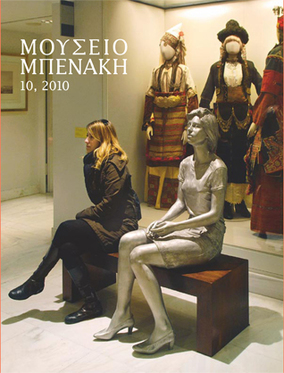Βιογραφική εικόνα του αγίου Γεωργίου στο Μουσείο Μπενάκη : συμβολή στη μελέτη του μεταβυζαντινού εικονογραφικού κύκλου του αγίου
Part of : Μουσείο Μπενάκη ; Vol.7, 2007, pages 67-93
Issue:
Pages:
67-93
Parallel Title:
The vita icon of Saint George in the Benaki Museum : Contribution to the study of the post-Byzantine cycle of the saint
Section Title:
Articles
Abstract:
This interesting vita icon of Saint George was gifted to the Benaki Museum collection. It is painted on a slightly curved panel 120 x 78 x 2.7 cm in size with an integral raised frame and takes the usual form for a vita icon with the saint occupying the central panel and scenes from his life on the four sides.St George is depicted according to the traditional facial type, full length and in frontal pose. He wears the military uniform with a rose-colored cloak and bears arms: lance, sword, bow and quiver with arrows. Punched lozenges and other geometrical motives decorate the halo and the background. The depiction of the saint follows the military saints’ iconography, which became widespread in Palaeologan art and took its definitive form in the Cretan painting of the fifteenth century in a series of high-quality pieces, such as the Sanctuary doors from the Evangelistria Museum on Tinos, the Benaki Museum triptych, the Hermitage triptych and the icon from the Likhachev collection.The fourteen episodes from the saint’s life are depicted in fourteen panels, different in size. They are described in detail in the Martyrdom of Saint George in the Great Synaxary edited by Constantinos Doukakis:1. The saint’s interrogation before the emperor 2. The martyrdom of the spear 3. The martyrdom of the stone 4. The martyrdom of the wheel 5. The angel rescues the saint from the wheel 6. The martyrdom in the lime pit 7. The flagellation 8. The resurrection of the dead man 9. The resurrection of Glykerius’ ox 10. The destruction of the idols 11. The visit of EmpressAlexandra in the prison and her reconversion 12. The Sentencing of the saint 13. The Death of Empress Alexandra 14. The Beheading of saint George.The iconographic analysis of each scene showed similarities in the composition of the cycle and the iconography of the scenes with the Cretan hagiographic icon of the late fifteenth century in the collection of the Ephorate of Byzantine Antiquities on Rhodes, the vita icon of the sixteenth century from the Ecclesiastical Museum in Pyrgos on Santorini, the hagiographic icon from the church of St George Yirokomeiou on Patmos dating from 1620 to 1630, the vita icon of the late seventeenth century from the Marpissa Museum on Paros and a vita icon of the eighteenth century in a French private collection. The model for 10 of the scenes goes back to the cycle on the carved wooden vita icon of the late eleventh - early thirteenth century from the National Art Museum of Kiev. The simple, symmetrical and well balanced compositions of this cycle, which apparently has survived, were adopted by Cretan artists of the fifteenth century and repeated in subsequent centuries, despite the fact that new iconographic types with strong signs of Western influence were created in the course of the sixteenth century. The cycle on the Benaki Museum icon presents certain iconographic peculiarities relating in the scenes of the Interrogation and the Sentence. The first one has the same iconographic schema with the scene of the Meeting with the emperor and his retinue at the temple of Apollo, as seen in the icon from Santorini, the Cretan icon from the Historical Museum in Geneva, a Melchite icon from the Abou Adal collection, an icon from the National Gallery of Sofia dated to 1684 and the icon from the French private collection. The scene of the Sentencing of the saint is rarely depicted. In the Benaki Museum icon it takes the schema of the emperor who is sited and writes the order of the decapitation as in the icons in Geneva and in the private collection in France. In Byzantine cycles it takes the same schema as the Interrogation.Stylistically the icon is related to the Mount Athos and more generally to Northern Greece workshops’ icon production of the first half of the seventeenth century, which they had Cretan icons as models, made popular through the work of Theophanes and his successors. The handsome and imposing figure of the saint with slender proportions, aristocratic face and refined features as well as the careful modelling bespeak an artist familiar with Cretan painting. However, the use of pink flesh tones on the face and hands of the saint and the colour range in his dress betray the icon’s place of production. Similar colours have been used in the life scenes, even if the execution is more sketchy and the folds of the drapery linear, indicating a close relationship with the painting techniques of Macedonian workshops.Other features, such as the thick, heavy wood, the integral frame, the red medallions with floral motifs and the punched decoration on the halo and background, all connect the icon with the products of Athonite and more generally Northern Greek workshops.The icon is distinguished by the imposing and noble figure of St George, the attention to the details, the interest in colour and the harmonious switching between the backgrounds against which the various episodes take place. The end product is an icon which is not only charming but particularly interesting inasmuch as it reflects the iconographical and stylistical influences between the workshops in the postbyzantine period.
Subject:
Subject (LC):




